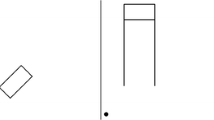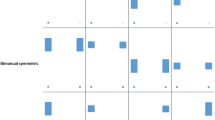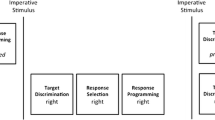Abstract
The goal of this study was to determine the process or processes most likely to be involved in reaction-time costs for spatially cued bimanual reaching. We used reaction time to measure the cost of bimanual symmetric movements compared to unimanual movements (a bimanual symmetric cost) and the cost for bimanual asymmetric movements compared to symmetric movements (a bimanual asymmetric cost). The results showed that reaction times were comparable for all types of movements in simple reaction time; that is, there was neither a bimanual symmetric cost nor an asymmetric cost. Therefore, unimanual, bimanual symmetric, and bimanual asymmetric movements have comparable complexity during response initiation. In choice conditions, there was no bimanual symmetric cost but there was a bimanual asymmetric cost, indicating that the preparation of asymmetric movements is more complex than symmetric movements. This asymmetric cost is likely the result of interference during response programming.




Similar content being viewed by others
References
Albert NB, Weigelt M, Hazeltine E, Ivry RB (2007) Target selection during bimanual reaching to direct cues is unaffected by the perceptual similarity of the targets. J Exp Psychol Hum Percept Perform 33(5):1107–1116
Anson JG, Bird YN (1993) Neuromotor programming: bilateral and unilateral effects on simple reaction time. Hum Mov Sci 12(1–2):37–50
Blinch J, Cameron BD, Franks IM, Chua R (2011) Bimanual reaches with symbolic cues exhibit errors in target selection. Exp Brain Res 212(4):541–554
Di Stefano M, Mortelli M, Marzi CA, Berlucchi G (1980) Hemispheric control of unilateral and bilateral movements of proximal and distal parts of the arms as inferred from simple reaction time to lateralized light stimuli in man. Exp Brain Res 38(2):197–204
Diedrichsen J, Hazeltine E, Kennerley S, Ivry RB (2001) Moving to directly cued locations abolishes spatial interference during bimanual actions. Psychol Sci 12(6):493–498
Diedrichsen J, Ivry RB, Hazeltine E, Kennerley S, Cohen A (2003) Bimanual interference associated with the selection of target locations. J Exp Psychol Hum Percept Perform 29(1):64–77
Diedrichsen J, Grafton S, Albert N, Hazeltine E, Ivry RB (2006) Goal-selection and movement-related conflict during bimanual reaching movements. Cereb Cortex 16(12):1729–1738
Elliott D, Allard F (1985) The utilization of visual feedback information during rapid pointing movements. Q J Exp Psychol Hum Exp Psychol 37(3):407–425
Favilla M (1996) Reaching movements: programming time course is independent of choice number. NeuroReport 7(15–17):2629–2634
Fowler B, Duck T, Mosher M, Matheison B (1991) The coordination of bimanual aiming movements: evidence for a progressive desynchronization. Q J Exp Psychol A 43(2):205–221
Goodman D, Kelso JA (1980) Are movements prepared in parts? Not under compatible (naturalized) conditions. J Exp Psychol Gen 109(4):475–495
Han S, Humphreys GW, Chen L (1999) Uniform connectedness and classical Gestalt principles of perceptual grouping. Percept Psychophys 61(4):661–674
Hazeltine E, Diedrichsen J, Kennerley SW, Ivry RB (2003) Bimanual cross-talk during reaching movements is primarily related to response selection, not the specification of motor parameters. Psychol Res 67(1):56–70
Heuer H (1986) Intermanual interactions during programming of finger movements: transient effects of ‘homologous coupling’. In: Heuer H, Fromm C (eds) Generation and modulation of action patterns. Springer, Berlin, pp 87–101
Heuer H, Klein W (2006a) Intermanual interactions related to movement amplitudes and endpoint locations. J Mot Behav 38(2):126–138
Heuer H, Klein W (2006b) The influence of movement cues on intermanual interactions. Psychol Res 70(4):229–244
Hick WE (1952) On the rate of gain of information. Q J Exp Psychol 4(1):11–26
Hughes CM, Franz EA (2007) Experience-dependent effects in unimanual and bimanual reaction time tasks in musicians. J Mot Behav 39(1):3–8
Hyman R (1953) Stimulus information as a determinant of reaction time. J Exp Psychol 45(3):188–196
Kawabe S (1989) Effects of force output and preparatory set on premotor time of simultaneous bilateral responses. Percept Mot Skills 68(2):619–625
Kelso JA, Southard DL, Goodman D (1979) On the coordination of two-handed movements. J Exp Psychol Hum Percept Perform 5(2):229–238
Klapp ST (1995) Motor response programming during simple and choice reaction time: the role of practice. J Exp Psychol Hum Percept Perform 21(5):1015–1027
Klapp ST (2003) Reaction time analysis of two types of motor preparation for speech articulation: action as a sequence of chunks. J Mot Behav 35(2):135–150
Marteniuk RG, MacKenzie CL, Baba DM (1984) Bimanual movement control: information processing and interaction effects. Q J Exp Psychol Hum Exp Psychol 36(2):335–365
Maxwell SE (2004) The persistence of underpowered studies in psychological research: causes, consequences, and remedies. Psychol Methods 9(2):147–163
Nagelkerke P (2002) Bimanual limb interaction. Unpublished master’s thesis, University of British Columbia, Vancouver, Canada
Norrie ML (1964) Timing of two simultaneous movements of arms and legs. Res Q 35(4):511–522
Norrie ML (1967) Effects of unequal distances and handedness on timing patterns for simultaneous movements of arms and legs. Res Q 38(2):241–246
Ohtsuki T (1981) Increase in simple reaction time of knee extension induced by simultaneous bilateral performance. Percept Mot Skills 53(1):27–30
Shen YC, Franz EA (2005) Hemispheric competition in left-handers on bimanual reaction time tasks. J Mot Behav 37(1):3–9
Spijkers W, Heuer H (1995) Structural constraints on the performance of symmetrical bimanual movements with different amplitudes. Q J Exp Psychol A 48(3):716–740
Spijkers W, Heuer H, Kleinsorge T, van der Loo H (1997) Preparation of bimanual movements with same and different amplitudes: specification interference as revealed by reaction time. Acta Psychol 96(3):207–227
Steenbergen B, Hulstijn W, de Vries A, Berger M (1996) Bimanual movement coordination in spastic hemiparesis. Exp Brain Res 110(1):91–98
Stelmach GE, Amrhein PC, Goggin NL (1988) Age differences in bimanual coordination. J Gerontol 43(1):18–23
Swinnen SP, Wenderoth N (2004) Two hands, one brain: cognitive neuroscience of bimanual skill. Trends Cogn Sci 8(1):18–25
Taniguchi Y (1999a) Effect of practice in bilateral and unilateral reaction-time tasks. Percept Mot Skills 88(1):99–109
Taniguchi Y (1999b) Right hemisphere contribution to motor programming of simultaneous bilateral response. Percept Mot Skills 88(3c):1283–1290
Weigelt M (2007) Re-examining structural constraints on the initiation of bimanual movements: the role of starting locations, movement amplitudes, and target locations. Hum Mov Sci 26(2):212–225
Weigelt C, Cardoso de Oliveira S (2003) Visuomotor transformations affect bimanual coupling. Exp Brain Res 148(4):439–450
Weigelt M, Rieger M, Mechsner F, Prinz W (2007) Target-related coupling in bimanual reaching movements. Psychol Res 71(4):438–447
Wenderoth N, Weigelt M (2009) Visual cues influence motor coordination: behavioral results and potential neural mechanisms mediating perception-action coupling and response selection. Prog Brain Res 174:179–188
Wright CE, Marino VF, Belovsky SA, Chubb C (2007) Visually guided, aimed movements can be unaffected by stimulus-response uncertainty. Exp Brain Res 179(3):475–496
Zelaznik HZ, Hawkins B, Kisselburgh L (1983) Rapid visual feedback processing in single-aiming movements. J Mot Behav 15(3):217–236
Acknowledgments
We would like to thank two anonymous reviewers for their insightful critiques. The Natural Sciences and Engineering Research Council of Canada supported this research with a postgraduate scholarship awarded to Jarrod Blinch and a discovery grant awarded to Romeo Chua. Brendan Cameron was supported by a Juan de la Cierva postdoctoral fellowship (JCI-2011-09664) and a Marie Curie CIG (618407). The views expressed here reflect those of the authors only and not those of the funders.
Author information
Authors and Affiliations
Corresponding author
Rights and permissions
About this article
Cite this article
Blinch, J., Cameron, B.D., Cressman, E.K. et al. Comparing movement preparation of unimanual, bimanual symmetric, and bimanual asymmetric movements. Exp Brain Res 232, 947–955 (2014). https://doi.org/10.1007/s00221-013-3807-7
Received:
Accepted:
Published:
Issue Date:
DOI: https://doi.org/10.1007/s00221-013-3807-7




